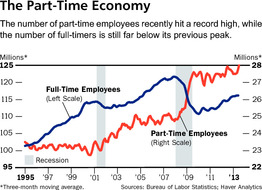 Gene Epstein documents in his latest “Economic Beat” column for Barron’s the “mini-revolution in part-time employment since the onset of this recession” in the United States.
Gene Epstein documents in his latest “Economic Beat” column for Barron’s the “mini-revolution in part-time employment since the onset of this recession” in the United States.
WHAT’S GOOD ABOUT these trends — and what’s bad?
On the positive side, the availability of part-time work is a boon to those who find it suits other commitments they make in life. Since women still tend to bear more of the burdens of raising a family, it’s no surprise that a disproportionate share of part-time work is still accounted for by women. In 1995, the female share of part-time work was a bit more than two-thirds, and today it’s a bit less than two-thirds. Meanwhile, the share of females in the labor force is still less than half.
But much of the revolution in part-time work has been fueled by the aging of the baby boomers. People begin to retire from work when they reach 55, but in lieu of retirement, they may seek part-time work. Today, more than 25% of part-time workers are 55 and older, up 18% from 1995. More than half the increase in part-time employment over this period has been accounted for by those 55 and older.
On the downside, however, not everyone wants part-time work. Many part-timers are hoping to work full-time, but can’t find these jobs.
The number of people working part-time who would prefer full-time work rose to a peak of 9.2 million in Sept. 2010, a doubling from 4.6 million in Dec. ’07. It has since declined to 8.2 million as of July, a drop of a nearly 11%. But that progress is maddeningly slow when compared, for example, with the decline in the number of unemployed, currently down more than 25% from its late 2009 peak.
On the downside, then, millions of part-time workers apparently feel trapped in those jobs, hoping for full-time work. They are part of the hidden unemployed.


